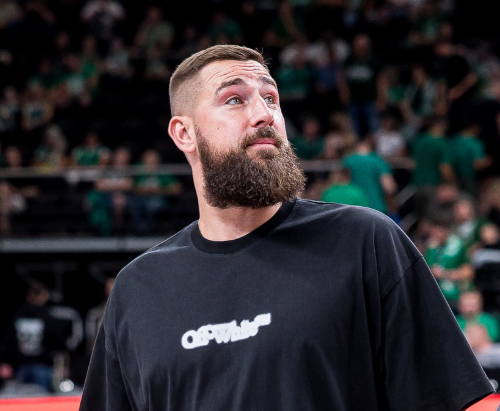Jonas Valančiūnas has subtly and steadily crafted a career over the last ten years that demonstrates both financial savvy and court durability. Despite being overshadowed by the wealth of superstars like LeBron James or Kevin Durant, his present estimated net worth of $35 million is still very outstanding when considering long-term dependability and intelligent decision-making. Valančiūnas has established his financial position by steady production and carefully negotiated contracts, in contrast to many of his more ostentatious peers.
He came into the league with great expectations and, by most measures, far surpassed them after being selected fifth overall by the Toronto Raptors in 2011. He earned about $45 million with Toronto alone, which was bolstered by a 2015 deal worth $64 million for four years. His worth grew more apparent over time, and several teams—including Memphis, New Orleans, Washington, Sacramento, and most recently, Denver—saw him as a very productive painter.
Jonas Valančiūnas – Bio & Financial Snapshot
| Attribute | Detail |
|---|---|
| Full Name | Jonas Valančiūnas |
| Birth Date | May 6, 1992 |
| Birthplace | Utena, Lithuania |
| Height | 7 feet 0 inches |
| Position | Center |
| Nationality | Lithuanian |
| NBA Draft | 2011, 1st Round (5th overall) – Toronto Raptors |
| Current Team (2025) | Denver Nuggets |
| Estimated Net Worth | $35 million |
| Total NBA Earnings | Over $140 million (2025 projection) |
| 2024-25 Salary | Approx. $15.4 million |
| Endorsements | Nike (regional), Lithuanian products, basketball gear deals |
| Verified Source | Celebrity Net Worth |
By 2025, Valančiūnas had made more than $140 million from NBA salaries alone. Incentives, bonuses, and playoff rewards are not even included in that amount. That total says a lot about a player who consistently ranks in the top 15 in terms of rebounding efficiency yet is rarely mentioned as an MVP. Even though his job started to shift more toward veteran leadership and bench support during the 2024–25 season, he still made about $15.4 million. He accepted the change with his usual quiet professionalism.
The NBA’s larger trend toward appreciating demonstrated experience is reflected in his most recent contract with the Denver Nuggets. With partial guarantees on the final season, the deal, which was negotiated following a series of trades involving the Kings and Wizards, pays about $30.3 million over three years. Early-career players typically focus on peak salary, while veterans like Valančiūnas focus on strategic structure, which includes positional leverage, guaranteed money, and team options.
By forming strategic alliances, Valančiūnas increased his income through sponsorship contracts. He signed a number of regionally focused campaigns, particularly in Eastern Europe, but he never rose to prominence as a Nike spokesperson. Additionally, he worked with Lithuanian businesses to market basketball equipment and health-related goods. Despite being little by superstar standards, these collaborations have brought in an estimated $3–5 million during his playing career.
His off-court endeavors have branched out into entrepreneurship and real estate in recent years. He first made investments in Vilnius residential real estate before moving on to American suburbs. According to reports, the value of these assets, which are kept through Lithuanian company shells, has increased gradually. He also holds minority shares in regional businesses, especially those that concentrate on youth development and sports technology.
He increased his visibility in charitable settings by sensibly using his public persona. He established the Jonas Valančiūnas Foundation in 2017, which mainly funds adolescent behavioral health programs. The 2018 launch of the adolescent day home “Išvien” (United) is among its most notable accomplishments. Lithuanian social services have hailed this effort as exceptionally successful, and it is still running in partnership with the MLSE Foundation and other European non-profits.
His financial prudence is quite comparable to that of NBA legends like Marc Gasol and Pau Millsap, who made the most of their contracts by being incredibly dependable rather than by having explosive moments. His earning window has been extended considerably longer than many of his draft peers due to his ability to avoid career-threatening injuries, maintain exceptional conditioning, and modify his playing style over time.
Mid-tier players like Valančiūnas have gained even more value in light of the CBA’s revisions and increased wage caps. In order to allocate their budgets to core role-players who provide locker-room presence, defensive steadiness, and mentoring for younger talent, teams are becoming less and less willing to overspend on supermax contracts. Valančiūnas has reacted to the changing economics of the league by embracing all three.
His net worth story provides a compelling model for longevity-based financial planning, even if he isn’t highlighted in shoe advertisements or on Forbes’ athlete rich lists. Following his career, he serves as a role model for Lithuanian youth in terms of both measured financial discipline and athletic achievement.
It’s interesting to note that he has contributed to culture outside of basketball. He contributed to bringing attention to Eastern European sporting potential worldwide by appearing in documentaries such as The Other Dream Team (2012) and We Are… for the Lithuania! (2012). Despite being specialized, his small acting role in Received Call 3 (2016) demonstrated his attempts to maintain cultural engagement even during busy times.
He has gained the trust of sponsors, franchises, and fans by keeping a relatively modest public profile and rarely making headlines for controversy or off-court trouble. Underpinned by discipline, strategic choices, and a humility that rarely makes headlines but always pays off, his net worth is the culmination of that trust.
The NBA’s financial narrative has changed over the last ten years, moving away from individual stardom and toward shared wealth. Jonas Valančiūnas and other players eloquently illustrate this growth. In the years to come, Valančiūnas’s tale will continue to be especially helpful as a model for consistency-driven success as newer players look for role models for managing their careers and wealth.


